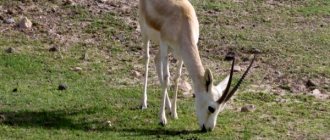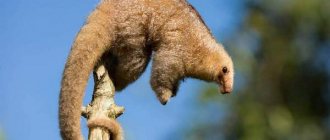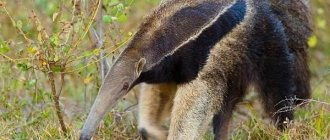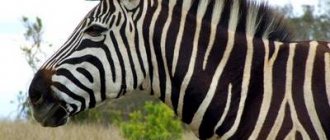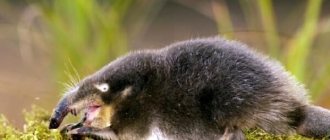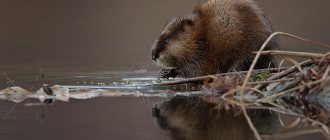- Wild animals
- >>
- Mammals
The armadillo is one of the most ancient representatives of the animal world. Zoologists consider it the most mysterious and incredible animal. Because of their large, thick shells, armadillos have long been considered relatives of turtles. However, after a series of genetic studies, they were identified as a separate species and order, which is similar to anteaters and sloths. In their historical homeland, Latin America, the animals are called “armadillos,” which means pocket dinosaurs.
Origin of the species and description
Photo: Battleship
Animals belong to chordate mammals. They are assigned to the armadillo squad. Scientists claim that these animals appeared on earth during the time of dinosaurs. This is approximately 50-55 million years ago. Armadillos have remained virtually unchanged since those times, except for a significant reduction in size.
The ancient ancestors of this species reached a length of more than three meters. These representatives of flora and fauna managed to survive and maintain their original appearance thanks to the presence of a shell made of dense bone plates, which reliably protected them from enemies and natural disasters.
Video: Battleship
The Aztecs, the ancient inhabitants of the American continents, called armadillos “tortoise hares.” This is explained by the association with wild hares, which had the same long ears as armadillos. Another similarity between armadillos and hares is their ability to live in dug burrows.
Almost all the remains of the ancient ancestors of these animals were discovered in South America. This gives reason to believe that this particular territory is the homeland and habitat of the main number of species of these animals. Over time, when the two American continents were connected by a land bridge, they migrated to North America. This is evidenced by fossil remains from a slightly later period. The remains of glyptodonts, the most ancient ancestors of armadillos, were discovered over a large area, right up to Nebraska.
In the mid-19th century, most armadillos concentrated in the south of America and live there to this day. In the early 20th century, several individuals escaped from private owners and established populations in the wild in the northern and western regions of America.
Appearance and features
Photo: Animal armadillo
The peculiarity of these unique animals is their shell. It consists of several sections that are connected to each other: head, shoulder and pelvis. The connection is ensured by elastic fabric. Thanks to this, all departments have sufficient mobility. Also on the body there are several ring-shaped stripes covering the back and sides. Due to the presence of such stripes, one of the species is called nine-banded. The outside of the shell is covered with strips or squares of epidermis.
The limbs of the beast are also protected by armor. The caudal section is covered with plates of bone tissue. The abdomen and the inner surface of the limbs are quite soft and sensitive skin, covered with hard hair. Hair can even cover the skin plates located on the surface of the shell.
Animals can have a very diverse range of colors. From dark brown to light pink. The hair may be dark, grayish, or completely white. The armadillo, despite its small size, has a squat, elongated and very heavy body. The body length of one adult individual ranges from 20 to 100 cm. Body weight is 50-95 kilograms.
The length of the tail part of the body is 7-45 centimeters. The muzzle of armadillos is not too large relative to the body. It can be round, elongated, or triangular in shape. The eyes are small, covered with rough, thick skin folds of the eyelids.
The limbs of animals are short, but very strong. They are designed for digging large holes. The front paws can be either three-toed or five-toed. The fingers have long, sharp and curved claws. The hind legs of the animal are five-toed. They are used exclusively for moving through underground burrows.
Interesting fact. Armadillos are the only mammals that do not have a standard number of teeth. In different individuals it can be from 27 to 90. Their number depends on gender, age, and species.
Teeth grow throughout life. The oral cavity has a long tongue covered with a viscous substance, which animals use to capture food. Armadillos have excellent hearing and sense of smell. The vision of these animals is poorly developed. They don't see color, they only see silhouettes. Animals cannot tolerate low temperatures, and their own body temperature depends on the ambient temperature and can range from 37 to 31 degrees.
2. They are also among the few mammals that lay eggs.
3. Armadillos got their name in honor of the conquistadors, Spanish warriors clad in steel armor.
4. South America is considered the homeland of these animals, but armadillos also live in Central and North America, as well as in Mexico.
5. In the Pleistocene era, glyptodons lived in South and Central America - giant relatives of modern armadillos. With its size and dimensions, glyptodon was similar to a Volkswagen Beetle. The body length of the ancestors of armadillos reached 3 meters.
6. Now giant armadillos weigh about 32 kilograms and reach one and a half meters in length.
7.The smallest armadillo is frilled - often does not exceed 15 centimeters in length.
8. Armadillos are sometimes confused with pangolins. But pangolins, or lizards, are a separate order of placental mammals.
9. Armadillos are animals that get their name from the shell that covers their body. It was this armor, consisting of bone plates, that allowed their ancient ancestors to survive.
10. The shell of these animals is a bone that grows directly from their vertebrae. A durable shell reliably protects the upper part of the animal’s body; it consists of hard plates that are covered with a keratinized layer of skin. All this helps armadillos protect themselves from predatory animals.
Armadillos roll up into a ball
11. Plates are also located on the shoulders and hips. On the back they consist of belts, between which there is a leathery layer, which allows the animals to curl up into a ball in case of danger.
12. But only one species of these animals can curl up into a ball to protect itself from attack. Those armadillos that do not know how to curl up into a ball will either run away when attacked, or will dig a hole where they can hide.
13. The head, upper paws and tail are usually also protected by armor. Therefore, the most vulnerable part of armadillos is the lower part of the body, which has only bristly hair.
14. Now there are about 20 species of these individuals and 9 genera, grouped into the following groups: bristly; hard armored; ball; large; frilled.
15. Of the 20 species of armadillos that exist, only one of them lives in North America. The rest are found in South America.
16. These animals live in tropical forests, grasslands and even semi-arid places.
cephalad-tailed armadillos
17. Head-tailed armadillos. This species has medium dimensions, body length is about 35-80 centimeters, body weight is 36-40 kilograms. A distinctive characteristic of this species is the tail of the animal; it is not protected by bone growths.
18. These animals have a wide muzzle with straight-set ears. There are 5 fingers on each limb, with the middle one being much larger than the others. Their body is covered with 9-13 movable plates. The color is dark, almost black.
19. The lifespan of this type of armadillo in its natural habitat is 11 years; survival rate in captivity is very low.
NINE-BANDED BATTLESHIPS
20. Nine-banded are the most famous and well-studied species of armadillo. These animals adapt well to their environment, so they are found everywhere.
21. Their habitat is wide, they are distributed not only in most of the United States, but also in Mexico.
22. Nine-banded armadillos love to dig holes on river banks near green bushes and trees; they can also cover short distances by swimming. For this feature they are called sea armadillos; the animal can hold its breath for up to 5-7 minutes.
Bristly armadillos
23. Bristly armadillos. Their characteristic feature is their small size; body length rarely exceeds 45 centimeters. Weight is 3.5-3 kilograms, their life expectancy is about 10 years.
24. Their body is covered with granular scutes and has a large amount of hair. These animals are light brown in color. They appear both during daylight hours and at night.
25.Bristly armadillos feed on carrion, worms and insects. They reproduce 2 times a year, and their pregnancies are infertile.
GIANT BATTLESHIPS
26. Gigantic or giant armadillos. Their body length is 1 meter, and their tail is 50 centimeters. Weight reaches 60 kilograms.
27. This animal has a tube-shaped muzzle and wide ears, and the number of teeth that do not have roots reaches 100 pieces. They are found in open meadows, savannas and jungles.
28. Frilled armadillos are often found in central Argentina, Bolivia, and Chile. They live in dry meadows with thorny bushes.
29. A sexually mature individual of these animals has a body length without tail of 10 centimeters, a tail of 2-3 centimeters, and their weight is 80-90 grams. These armadillos look small and defenseless. Their color varies from soft pink tones to dark, rich shades.
30. Their small, elongated head and strong forelimbs are perfectly adapted for digging holes. These animals spend most of their time underground. They are active at night. This type of armadillo is in danger of extinction.
Dwarf armadillos
31. There is also a dwarf species, their body size is 26-35 centimeters, weight is about 1 kilogram.
32. Scientists cannot reliably find out how many teeth each type of armadillo has. It is known that their jaws are not very powerful, and their rare teeth are peg-shaped and practically not covered with enamel.
33. This structure is explained by the fact that the animals feed on soft food, which is digested in the stomach, the anterior section of which is covered with hard plates. The teeth have one root and grow throughout the animal's life.
34. Most armadillos are unable to curl into a ball because they have too many plates that limit their flexibility.
35. Armadillos are clumsy animals with an elongated muzzle and huge erect ears. They come in black, dark brown, gray, red and even yellow.
36. These animals are omnivores. Their diet is based on a variety of insects and larvae; armadillos can also eat plant foods or carrion.
37. Armadillos are excellent at digging - this is how they find food for themselves, namely insects, as well as small mammals, roots and fruits.
38.Besides digging, armadillos have a fantastic sense of smell for finding food. They can smell prey even underground. This compensates for the fact that they have very poor eyesight.
39. Ants and termites are considered their special delicacy; they are not afraid of their bites; armadillos dig them out with their clawed paws. Their long, sticky tongues help them suck up ants (including fire ants) and termites.
40.Their front and hind legs have from 3 to 5 fingers and large sharp claws, which help the animals dig the ground, open anthills and termite mounds. Large species can even break up tree stumps or termite mounds and then take the prey with their long tongue.
41. Thanks to the large salivary glands located on the lower jaw and reaching the sternum, the tongue is constantly covered with mucus. At one time the animal eats up to 35 thousand insects.
42.The most common type of armadillo, the nine-banded armadillo, is capable of eating about 40 thousand ants in one sitting.
43. Some species feed on small invertebrates in the warm season and can also eat fruits. Sometimes they supplement their diet with eggs from birds that build nests on the ground.
44. These animals, despite the fact that they spoil crops when digging up the ground in search of food, also bring a lot of benefit by destroying harmful insects and their larvae.
45. These animals do not have very good eyesight and do not distinguish colors at all, but they have a fairly developed sense of smell and excellent hearing. This helps to recognize members of their own kind, as well as receive information about the readiness of the opposite sex to reproduce.
46. Since armadillos belong to the group of mammals, they are placental. The placenta is formed only during pregnancy, through it nutrients enter the fetal body, cells are saturated with oxygen and hormones are produced that are responsible for the growth of the fetus.
47. The mating season occurs in the warm season, most often in July; it is at this time that females are physiologically ready for mating. Conception occurs through sexual intercourse and often only one egg is fertilized.
48. At the earliest stage, the embryo remains in the uterus for about 3-3.5 months, then implantation occurs and the fetus develops for another 4 months. Delaying implantation is necessary to ensure good survival of the offspring.
BABY ARMADOXES
49. Cubs are born in early spring, they are well developed and can move independently within a few hours after birth.
50. The shell of babies is soft, and only at the onset of puberty does it harden.
51.During the first months, newborns remain close to their mother, who feeds them with breast milk.
52.Next, the already grown cubs leave the hole and begin to master adult food. Development is fully completed by 3-4 years, depending on gender.
53. The bulk of the animals are nocturnal, but activity can vary depending on the weather and the age of the armadillo. Juveniles may emerge from their burrows early in the morning or around lunchtime. During the cold season, animals are also active during the day.
54. No family of mammals has such a variable number of teeth - from 28 to 40 (in the giant armadillo - up to 90-100). The number of teeth varies not only among different species, but also among different individuals.
55. Because of their thin shell and low body fat, armadillos cannot maintain their internal temperature like most other mammals.
56.On earth, among mammals unrelated to humans, only armadillos and mice become infected with leprosy. Infection is most likely facilitated by the low body temperature of armadillos (32 degrees Celsius), which is favorable for Hansen's bacilli.
57. Over the course of their entire lives, female armadillos give birth to an average of about 56 babies.
58. Nine-banded armadillos are of great scientific interest because they usually give birth to 4 identical twins.
59. Due to their complete identity, a group of four armadillos is an excellent subject for medical, genetic, psychological and other studies that require a homogeneous composition of test subjects.
60. These animals are almost always found alone; it is very rare to see them in a small group.
61. Armadillos live in warm, sandy soil, digging burrows. The burrows of these animals can be quite deep, reaching 5-7 meters, they have various branches and passages, and the bottom of the home is covered with dry leaves.
62. Armadillos can sleep 16-18 hours a day. Armadillos spend most of the day in burrows, and at night they come out to eat. They move slowly and carefully, stopping often to sniff the air. Their gait looks slightly awkward. The hind limbs rest on the foot, and the front limbs on the tips of the claws. The dense, heavy shell also prevents them from moving quickly, but in the event of an attack by predators they are able to develop speed and quickly hide in a hole or in dense bushes.
63. Armadillos are objects of hunting. Their white meat, which tastes like pork, has been considered a delicacy among the peoples of Latin America since ancient times.
64. The indigenous people of South America used their shells to make roofs for huts. The result was a kind of durable tile.
65. Armadillo shells are traditionally used to make a South American lute-type instrument called a charango.
66. Armadillos are often hit by cars at night. At the same time, nine-banded armadillos are destroyed by the jumping reflex. When frightened, this animal jumps almost vertically and hits the chassis of a moving car.
67. Armadillos are often preyed upon by a variety of animals: wolves, coyotes, bears, lynxes and jaguars.
68. In a number of countries, these animals are under state protection, and several species are even listed in the Red Book, but despite this, they continue to be exterminated.
69.This is especially true for giant species, which have become quite rare. More often you can see small individuals, ranging from 18 to 80 centimeters in length.
70. Male armadillos, proving their superiority over the opposite sex, can start fights. They try to knock the opponent onto his back in order to gain access to the most unprotected places.
71. In dangerous moments, these animals press tightly to the ground and squeeze their limbs into their shell.
72. In stressful situations, female armadillos can stop giving birth for two years.
73. If an armadillo encounters an obstacle that he cannot crawl under, then he will do everything possible to climb over it, like the most seasoned climber.
LONG-HAIRED ARMADILLAS
74. One type of armadillo can scream loudly when threatened. This is a long-haired armadillo.
75. When these animals dig holes, they do not breathe so that the earth does not get into their respiratory tract.
76. Life expectancy of animals varies from 7 to 20 years, and survival rate in captivity is higher than in natural conditions.
77. Moreover, young individuals have a lower survival rate. Survival in nature is influenced by the following factors: Climatic conditions - drought, too high or low temperatures can cause the death of young animals.
78. Animals of prey are an important point that increases the mortality of cubs that have a soft shell and insufficient physical endurance.
79.Diseases and infections significantly reduce survival. Also significantly reducing the population size and lifespan is the fact that they are hunted by people and their habitats are destroyed.
80. Armadillos, along with bonobo chimpanzees and humans, are mammals that mate in the “missionary position.” After death, the armadillo's genitals remain active for some time.
81. Armadillos are not afraid of people, and can climb into houses in search of food supplies.
82. It is known that the bristly armadillo builds its home not with the help of sharp claws, but with its head. The animal sticks it into the ground and begins to turn, as if spinning into it. So he not only digs a hole, but also at the same time gets food and eats it.
83. Armadillos can hold their breath, which allows them to hide from predators at the bottom of a body of water along which they move on foot.
84. Armadillos can reach speeds of up to 48 km/h! This helps them escape from predators almost effortlessly.
85. The armadillo was the mascot of the 2014 FIFA World Cup - and it was the only species that can curl up into a ball.
photo from the Internet
Where does the armadillo live?
Photo: Armadillo in South America
Geographical regions of the animal's habitat:
- Central America;
- South America;
- Eastern Mexico;
- Florida;
- Georgia;
- South Carolina;
- Trinidad Island;
- Tobago Island;
- Margaret Island;
- Grenada Island;
- Argentina;
- Chile;
- Paraguay.
Armadillos choose a subtropical, hot, dry climate as their habitat. They can live in rare forest areas, grassy plains, valleys of water sources, as well as areas with low vegetation. They can also inhabit savannas, rain forests, and deserts.
Different species of these representatives of the animal world choose their region and living conditions. For example, the furry armadillo is an inhabitant of mountainous areas. Can climb to a height of 2000-3500 meters above sea level.
Armadillos are not embarrassed by the close proximity of humans. Ball armadillos are distinguished by their flexible, tame nature. Can get used to being in constant proximity to a person. If he also feeds him and does not show aggression, then he is able to play with him. Animals have the ability to quickly settle down and get used to a new environment when changing their place of residence.
What does an armadillo eat?
Photo: Mammal armadillo
When living in natural conditions, it feeds on food of both animal and plant origin. The main food source that armadillos consume with the greatest pleasure are ants and termites. Most armadillo species are omnivores. The nine-banded armadillo is considered an insectivore.
What is included in the diet:
- Worms;
- Ants;
- Spiders;
- Snakes;
- Frogs;
- Termites;
- Scorpios;
- Larvae.
They can feed on small invertebrates, such as lizards. They also do not disdain carrion, food waste, vegetables, and fruits. They eat bird eggs. As plant food, it can consume succulent leaves, as well as roots of various types of plants. Cases of attacks on snakes are common. They attack them by cutting the snake's body with the sharp tips of its scales.
Interesting fact. One adult can eat up to 35,000 ants at a time.
To search for insects, animals use powerful paws with huge claws, with which they dig the ground and dig them out. When they are hungry, they move slowly with their muzzle down and turn over dry vegetation with their claws. Powerful, sharp claws allow you to disassemble dry trees, stumps and collect insects hiding there with their sticky tongue.
Interesting fact. Large, strong claws allow you to rake even asphalt.
Armadillos often make their burrows not far from large anthills so that their favorite treat is always nearby. The nine-banded armadillo is one of those species that can even eat fire ants in large quantities. Animals are not afraid of their painful bites. They dig up anthills, eating ants and their larvae in huge quantities. In winter, with the onset of cold weather, when insects are almost impossible to find, they switch to a plant-based diet.
Nutrition
More than ninety percent of their diet (by volume) consists of animals. Adult beetles and larvae form the bulk of the diet, but armadillos also feed on termites, centipedes, labiopods, ants, grasshoppers, arachnids, earthworms, and several other insects and terrestrial invertebrates.
Armadillos also feed on small reptiles and amphibians, especially in winter when these animals are more lethargic. They sometimes eat baby mammals or bird eggs. Less than ten percent of their diet consists of plant matter such as fruits, seeds, and mushrooms. Earth, twigs, tree bark, and other indigestible foods were found in their stomachs, but the consumption of such substances was probably accidental. Armadillos sometimes eat carrion, but are more interested in the larvae that inhabit the carcasses than in the meat itself.
The animals rely primarily on their sense of smell to find food sources and often visit shallow burrows in search of invertebrates.
Features of character and lifestyle
Photo: Armadillo Red Book
Animals tend to lead an active nocturnal lifestyle. Young individuals can be active during daylight hours. With the onset of cold weather and a sharp reduction in the food supply, they can also leave their shelters during the day in search of food.
In most cases, armadillos are solitary animals. In rare exceptions, they exist in pairs or as part of a small group. They spend most of their time in burrows located underground and come out at nightfall in search of food.
Each animal occupies a certain territory. Armadillos make several burrows within their habitat. Their number can be from 2 to 11-14. The length of each underground burrow is one to three meters. The animal spends in each hole from several days to a month alternately. The burrows are usually shallow and located horizontally to the ground surface. Each of them has one or two entrances. Very often, due to poor eyesight after a hunt, animals cannot find the entrance to their house and make a new one. In the process of digging holes, animals protect their heads from sand. The hind limbs are not involved in digging holes.
Each animal leaves marks with a specific odor within its habitat. The secretion is secreted by special glands, which are concentrated in various parts of the body. Armadillos are excellent swimmers. The large body mass and heavy shell do not interfere with swimming, since the animals inhale a large amount of air, which prevents them from sinking to the bottom.
Animals seem clumsy, clumsy and very slow. If they sense danger, they are able to instantly burrow into the ground. If an animal is frightened by something, it jumps very high up. If, when danger approaches, the armadillo does not have time to bury itself in the ground, it presses against it, hiding its head, limbs and tail under its shell. This method of self-defense makes them inaccessible to attacks from predators. Also, if necessary, they can develop a fairly high speed to escape from being chased.
Animal lifestyle
A large number of armadillos are nocturnal. Quite often, animals live alone, sometimes in pairs, and very rarely in small groups. In the area where the mammals have settled, you can find from 1 to 20 dug holes. The length of the shelter can vary from 1.5 to 3 m. Burrows can have several exits.
Despite their heavy shell, armadillos swim well and dive excellently, holding their breath for a long time.
Social structure and reproduction
Photo: Baby armadillo
The period of marriage is seasonal, most often occurring in the summer. Males court females for quite a long time. After mating, pregnancy occurs, which lasts 60-70 days.
Interesting fact. After the formation of the embryo, females experience a delay in its development. The duration of such a delay ranges from several months to one and a half to two years.
This process is necessary to ensure that the offspring are born during the most favorable climatic conditions, which will increase the chances of survival of the cubs.
Depending on the species, one mature female can give birth to from one to four to five cubs. The birth of offspring occurs no more than once a year. At the same time, a third of sexually mature females do not participate in reproduction and do not produce offspring. Babies are born quite small. Each of them sees at birth and has a soft, non-keratinized shell. It completely ossifies at about six to seven months.
Interesting fact. Certain animal species, including nine-banded armadillos, are capable of producing identical twins. Regardless of the number of cubs born, they will all be either females or males and develop from a single egg.
A few hours after birth, they begin to walk. For one to one and a half months, the cubs feed on mother's milk. After a month, they gradually leave the hole and join adult food. The period of puberty in both males and females occurs after reaching one and a half to two years.
In some cases, when the female has no milk and has nothing to feed the cubs in a state of panic, she can eat her own. The average life expectancy in natural conditions is 7-13 years, in captivity it increases to 20 years.
Lifespan
The lifespan of armadillos ranges from 7 – 8 years to 20 or more. At least one nine-banded armadillo has reached 23 years of age in captivity. Juveniles have a higher mortality rate than adults.
Factors affecting lifespan include climate conditions, predation and disease. Because this species does not have a significant amount of fur or fat, it does not cope well with cold temperatures. A large adult male can survive no more than 10 days at 0°C. The larger the animal, the more likely it is to be able to survive cold temperatures. Other environmental conditions, such as drought, also influence the mortality of these mammals.
Predation and killing by humans, both targeted and accidental, are significant causes of mortality. Cubs are more likely to be killed by predators in the wild than adults due to their weaker physical condition and softer armor.
Disease may be an important factor contributing to armadillo mortality. In one population, 30% of adults were found to have bacteria associated with disease, while 17% had antibodies, indicating previous infection.
Natural enemies of armadillos
Photo: Animal armadillo
Despite the fact that nature has awarded armadillos with reliable protection, they can become prey to larger and stronger predators. These include representatives of the predatory families of cats and dogs. Alligators and crocodiles can also hunt armadillos.
Armadillos are not afraid of being close to humans. Therefore, they are often hunted by domestic cats and dogs. Humans are also the cause of animal extermination. He is killed for the purpose of obtaining meat and other body parts, from which souvenirs and jewelry are made.
The cause of extermination by humans is harm to livestock. Pastures riddled with armadillo burrows are the cause of broken limbs in livestock. This forces farmers to exterminate the animals. A large number of animals die under the wheels of vehicles on the highway.
Economic significance for humans: Negative
Despite catching agricultural pests, armadillos can cause damage to farmers. They feed on several crops, including peanuts, corn and melon. Their holes pose a threat to farm animals that may accidentally fall into them. In addition, burrows can weaken roadsides and dams. Armadillos are also carriers of various diseases.
Population and species status
Photo: Battleship South America
To date, four of the six existing species of armadillos are listed in the International Red Book. Zoologists say that one of the species, the three-banded armadillo, may already be completely exterminated. This is due to low birth rates. A third of sexually mature females do not participate in reproduction. Some types of armadillos are capable of reproducing up to ten young. However, only a part of them survive.
For quite a long period of time, Americans destroyed armadillos because of their tender, tasty meat. Today in North America their meat is still considered a great delicacy. In the 20-30s of the 20th century, they called them lambs and made meat reserves, destroying the animals. The means of self-defense in the form of a shell makes them easy prey for humans, since they do not run away, but, on the contrary, simply curl up into a ball. One of the reasons for the extinction of the species is considered to be the destruction of its natural habitat, as well as deforestation.
Habitat
Nine-banded armadillos are most commonly found in forested and shrubby regions of tropical and temperate zones. Also found in grasslands and savannas around wooded areas. Armadillos prefer forests over grasslands because they forage on the forest floor. Mammals are not often found in arid regions; they choose coastal areas or areas with sufficient water, or minimal precipitation of 38 cm per year. They have also been found near wetland areas, but do not frequently inhabit them.
Temperature is an important condition when choosing a habitat. Armadillos are not comfortable in temperatures less than 22° Celsius, but warm burrows allow the animals to inhabit temperate areas.
Armadillos' habitat is not limited by the presence of humans; they do not often inhabit areas with dense human populations.
In forests, meadows and bushes, armadillos live in underground burrows. They vary in size, but can be up to 5 meters wide and 2 meters deep. Armadillos bring some herbs and leaves into their burrows, and often hide the entrance with plants. Females and males may share a burrow during the breeding season, but generally burrows are shared only between a female and her cubs or young siblings.
